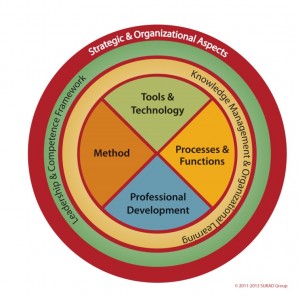Introduction
This week we published an article on building the project management organizational system. In that article we suggested our approach, using the SUKAD Seven Elements of Project Management Maturity.
One of those elements is: “Professional Development” and another is “Leadership and Competence Framework”. Today’s article touches on both of these elements, with one of the possible ideas to implement in organizations that believe in the strategic value of project management!
In addition to the above, we had posted another article in the past about “The Accidental Project Manager – Challenges to Executives” and we had received a reader comment stating that one of the issues that lead to executives making the wrong decision is the lack of two organizational streams (or ladders). The lack of two ladders is what create the environment to have accidental project managers, which in turn lead to projects’ failure or challenges in managing projects.
What are we talking about?
What do we mean my two organizational ladders?
One professional ladder
 Most organizations today have one professional ladder, where a team member join the organization, either out of college or other sources, and if the person is ambitious, her (it is still mostly “his”) eyes would be on a senior position within the organization, if not the top:).
Most organizations today have one professional ladder, where a team member join the organization, either out of college or other sources, and if the person is ambitious, her (it is still mostly “his”) eyes would be on a senior position within the organization, if not the top:).
To get there, she has to grow through the rank from an apprentice to a professional contributor and onward to a manager and senior manager, and ultimately the top of the pyramid; if no glass ceiling. Obviously most could not go to the top and will end up stuck on one of the intermediate rungs of the ladder. This situation may lead to the “cycle of doom” with declining performance as the person collect years and dust in their job, along with diminishing their value to the organization.
Under this scenario, if we follow a person career path, how would it look like?
Let us say we have a programmer, engineer, marketing graduate, or any other function. Typically, most organizations’ human resource systems have grades (levels) for these professional positions, such as Engineer I, Engineer II, Engineer III, or Marketing Coordinator, Senior Marketing Coordinator … etc.
OK – Fair. What is next?
Well, in most organizations (from our observations), that grading (level) system stop at 2, 3, or maximum 4 levels above entry position.
So what is next for the aspiring professional?
Nothing – the person either get stuck for the rest of her career in that position, or leave, or if she is an excellent performer, then possibly move into the manager position.
With such a move the person would have shifted from the professional ladder and start to climb the management ladder.
Is this the two ladders system?
Not really. In the above scenario, what we described is a very short professional ladder; more like a step ladder with two or three steps. As a result, the only way a person can climb higher is by shifting from the step ladder to a full length ladder; in other words from technical to management ladder.
That is not so bad … why not?
In some instances, nothing is wrong with this scenario and it is natural progression for a person to climb; until the person reach the top or is promoted to “her level of incompetence” where she will be stuck.
The issues with one ladder are: let us put them in the form of questions:
- Are the professional or technical skills that help a team member perform well in a job function, the same type of skills needed to manage a team?
- Even if a person has the skills, do they really like to be on the management ladder or stay in their professional track?
- What would happen if the top performer (in a job function) does not have the necessary skills to manage a team and we bypass her for teammate who is good in managing people but not as a good in the functional job? Would this be accepted by the top performer or demotivate her?
Without getting into the academic research on the above situation, we know that a one ladder scenario is a contributing factor to office politics, de-motivation, people leaving, etc. In general, the above is an organizational model that many subscribe to with advantages and disadvantages.
The two ladders model
An alternate to the earlier model, is the two tracks – two ladders model, a professional ladder and a management ladder.
Let us go back to a young professional career.
A young professional start their career out of college and let us say they do well, they climb one step, two steps but remaining in their technical track. In the earlier situation (one ladder) the person will reach either a road block or move into management to continue to grow in the organizational hierarchy.
In the two ladders system, after a couple of steps, the individual might discover that they have good management and leadership skills and want to move to management. If the organization recognizes the employee and his skills – great we have a match and we are back to the one ladder model.
On the other hand, if the team member really enjoys the “functional aspects” of his work … and … he is good at it … and … he does not like to manage people … what happen?
In the one ladder system … the employee is stuck, will become demotivated … etc. Refer to earlier discussion …
In the two ladder system, the organization would have a professional ladder that rise quite high, not all the way to the top but close enough. On this ladder the person can climb in their professional domain to become the top expert in the company for this domain with the salary and benefits of top executives but without having to manage people, a department, or a business unit.
We can expand on this topic more, maybe in a future article. For now, what do you think? Is this a good alternative model? What are the advantages and disadvantages?
SUKAD offers consultancy and organizational solutions on the above topic but only for project management functions.


You can this in “industrial” countries like the USA or Germany or France etc… Because there is always need to technical development. However if this is not the case, a change to specific areas in corporate management like Sales, Marketing or Accounting will be the only way to this career progress.
It is country ad organization dependent.
Dear Mr Kamel
Thank your for your participation and responding. Yes, i agree with you that such an approach is organization dependent and it could be country dependent but it does not have to be this way.